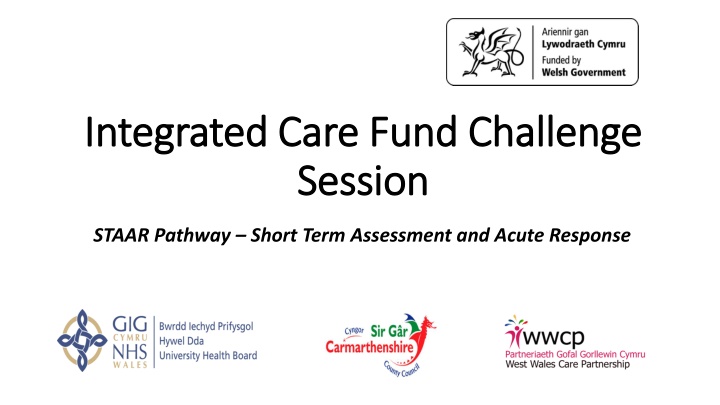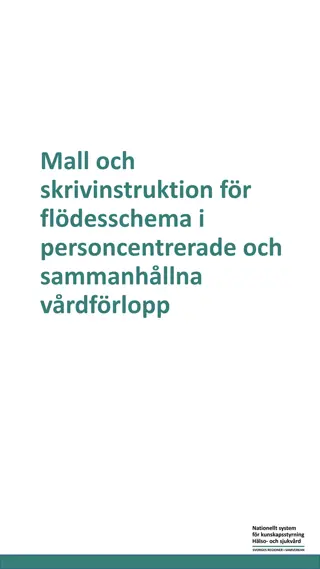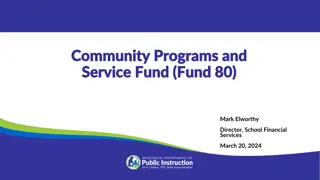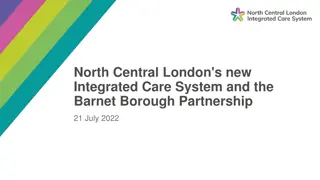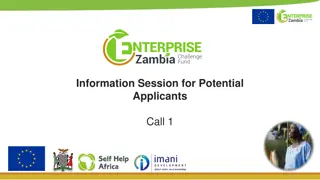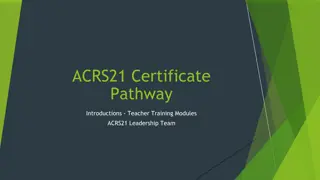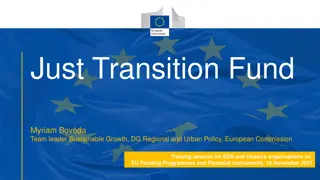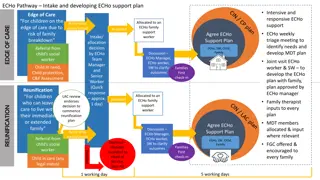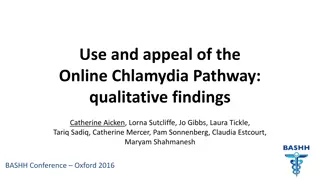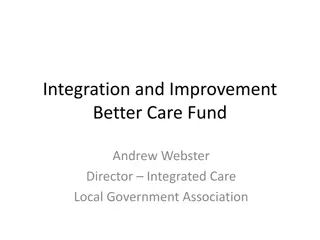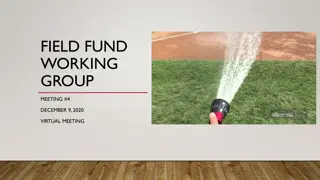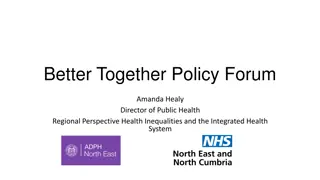Integrated Care Fund Challenge: STAAR Pathway for Sustainable Services
The Integrated Care Fund Challenge introduces the STAAR Pathway, a short-term assessment and acute response program aimed at preventing, delaying, or reducing care needs. Through a multi-disciplinary team, the program provides a range of services to individuals, emphasizing prevention and early intervention to sustain services in the future. With a budget allocation and tie-in with ICF objectives on prevention, the project focuses on various types of referrals for reablement, early intervention, short-term support, and long-term needs assessment. The aim is to address needs promptly, minimizing crisis responses and hospital admissions.
Download Presentation

Please find below an Image/Link to download the presentation.
The content on the website is provided AS IS for your information and personal use only. It may not be sold, licensed, or shared on other websites without obtaining consent from the author.If you encounter any issues during the download, it is possible that the publisher has removed the file from their server.
You are allowed to download the files provided on this website for personal or commercial use, subject to the condition that they are used lawfully. All files are the property of their respective owners.
The content on the website is provided AS IS for your information and personal use only. It may not be sold, licensed, or shared on other websites without obtaining consent from the author.
E N D
Presentation Transcript
Integrated Care Fund Challenge Integrated Care Fund Challenge Session Session STAAR Pathway Short Term Assessment and Acute Response
STAAR Pathway STAAR Pathway - - Project Introduction Project Introduction Overview of service provided The service is provided by staff rotating into a multi-disciplinary duty team. Referrals are received from the IAA service. The team will use the referral information, together with further information gathered from other sources to identify cases that could be suitable for a short term intervention. These cases should receive an assessment the same working day followed by an appropriate intervention or support. Staff structure additional resources allocated to the 3 Localities: 3 x Social Workers Grade I 3 x Occupational Therapists Band 6 2 x Physiotherapists Band 7 and Band 5 Stroke Pathways 2 x Physiotherapy Technicians Band 4 Stroke Pathways 3 x Nurses Band 6 Core Community Nursing
Funding arrangements Funding arrangements: Budget: 1,922,291 For Intermediate Care Pathway 100% Funding from ICF: Any other funding: N/A Spend 2017/18 (incl spend to date): Projected 2019/20 budget required: 350,459 to Dec 476,938 projected to March TBC
Project tie-in with ICF objectives PREVENTION There is a need to focus on prevention and early intervention to make services sustainable into the future. Section 15 of the Social Services and Well-being (Wales Act) 2014 places a duty on local authorities to provide or arrange the provision of preventative services which they consider will achieve the following purposes: a) Contributing towards preventing or delaying the development of people s needs for care and support; b) Reducing the needs for care and support of people who have such needs. STAAR Pathway aims to prevent, delay or reduce people s needs for care and support
Main types of Referrals Individuals requiring Reablement as a preventive service Individuals requiring early intervention such as OT / Physio assessment, equipment, advice on reducing risks, advice on adjustments to the way they carry out activities of daily living Individuals requiring additional short term support or short term placement Individuals requiring advice, signposting to 3rdsector services or telecare Individuals requiring a SSWBA assessment of long term needs Notably, very few referrals requiring a crisis response to prevent hospital admission
STAAR Pathway - Activity 2017/18 and 2018/19 Activities Triggered to Desktops from IAA = 16,000 5000 4500 0 0 0 0 0 756 4000 0 0 0 0 0 0 0 0 0 0 54 301 3500 835 803 475 3000 226 507 1496 1337 2500 1539 2000 114 1519 1500 1055 213 1000 STAAR 1645 265 STAAR 1079 500 865 STAAR 754 118 0 0 0 0 0 0 20 15 3Ts 0 A&G Llanelli County Long Term STAAR HI&VI SW Physio OT GGH PPH Telecare Safeguarding Other Miscellaneous
Flow of Referrals (2017 & 2018) Referrals 21,265 Further Assessment 18,713 IAA Outcome (12%) Hospital Teams 1,920 Telecare 1,496 Safeguarding 301 CRTs 8,742 STAAR 3,478 Long Term SW Named worker Blank OT Physio Telecare
STAAR Pathway - Activity Activities Triggered to STAAR and CRTs 3478 28% 8742 72% STAAR CRT
Where STAAR Screening Forms were triggered Screening Forms - where triggered to (3465 forms in 2018) 1800 1556 1600 1400 1200 1000 800 642 600 439 356 400 148 200 123 75 67 59 0 Blank OT Physio A&G 3Ts Llanelli Named worker Telecare Other
Project Issues / Challenges Not multi-disciplinary mainly SW & OT Consistency across the 3 CRTs much higher proportion of STAAR cases progressing to long term in A&G What kind of Intermediate Care service is STAAR? Most closely matches the definition of home-based Assessment and interventions to people at home to regain independence However, the main difference is that the STAAR Pathway does not hold clients for a number of contacts over a 4 week period. No team ownership. Service users referred on by STAAR to other desktops, quite frequently multiple desktops.
Key case studies Mr A has terminal cancer, stage 4, too weak to shower for last 3 weeks. Referral reviewed by SW / OT / Nurse, Joint visit by OT & SW. Physio referral made to review walking aids. OT prescribed equipment to aid washing and toileting and gave advice to reduce falls risks. SW arranged domiciliary care, 1 call per day but service declined on the basis of the charge of 31.50 p.w. Referral to Palliative care OT. How did patient benefit? Client received a response within one week of referral which prevented the development of his care needs Lessons learned? Earlier discussion about charging would have prevented needless commissioning of a service which was then declined
Key case studies Mr B referred by GP: Please could you assist this gentleman who live alone and his mobility is poor but is just about coping around the house. He cannot cook, he hasn't had a proper meal in many months and is feeling lethargic with bouts of confusion and he is struggling to take his medication as prescribed. Mr B reported to IAA that he is struggling with bathing and can t afford heating or meals on wheels. IAA referred to Floating Support and to Telecare then triggered referral on to STAAR. Referral reviewed by MDT, follow up call by SW. Physio referral made to review walking aids. OT referral made to assist with bathing aids declined appointment at present. Client declined SSWBA assessment. Client declined medication dispenser but accepted lifeline and safety sensors. Client declined benefits check. How did patient benefit? Client received a response within one day of referral and Telecare visit within one week which reduced risks at home. OT follow up took 3 months. Physio follow up completed? Lessons learned? Was Mr B given choice and control on what support he wanted? Numerous professionals involved in a simple referral. There were 7 attempted hand offs no case coordination, poor customer experience?
Sustainability plan ICF funding will be sought in order to continue development Implications if the project were to cease would be that people requiring a short term intervention at home would not receive the most appropriate response promptly
Project development STAAR needs further development clear purpose and aims; protocols and standardisation of practice; activity and performance measures Dedicated multi-disciplinary teams are key to improving case coordination and customer experience Clear identity as a home-based intermediate care service within the overall Intermediate Care strategy Need to develop a crisis response service and the appropriate assessment for accessing crisis response TOCALS and STAAR could be the assessment services - using Comprehensive Geriatric Assessment tool to screen for Frailty
IAA receive Referral and prioritise those for rapid assessment Multi-disciplinary Rapid Assessment STAAR & TOCALS within 4 hours 7 day, 8am-8pm service 24/7 service 3rdSector Services: Home from Hospital Home not Hospital 7 day, 8am-8pm 1 day response Up to 4 weeks MDT support not needed: Telecare Advice / Signposting Restart / short term increase POC Bed based services Reablement Crisis Response Home based service 7 day, 7 am 10 pm 24/7 service 3 day response 2 day response GERIATRICIAN LED THERAPY LED 4 to 6 weeks Usually up to 6 weeks 5 day, 9am 5pm service 24/7 service 4 hour response 1 day response Community Hospital Up to 7 days Up to 28 days Residential Reablement
Help to help yourself A little help when you need it Complex MDT Support
Conclusion Further work on home-based and crisis-response intermediate care models is ongoing The intermediate care pathway also needs development Access hours to services are critical to effectiveness in terms of keeping people at home Debra Llewellyn, Modernisation Programme Manager
